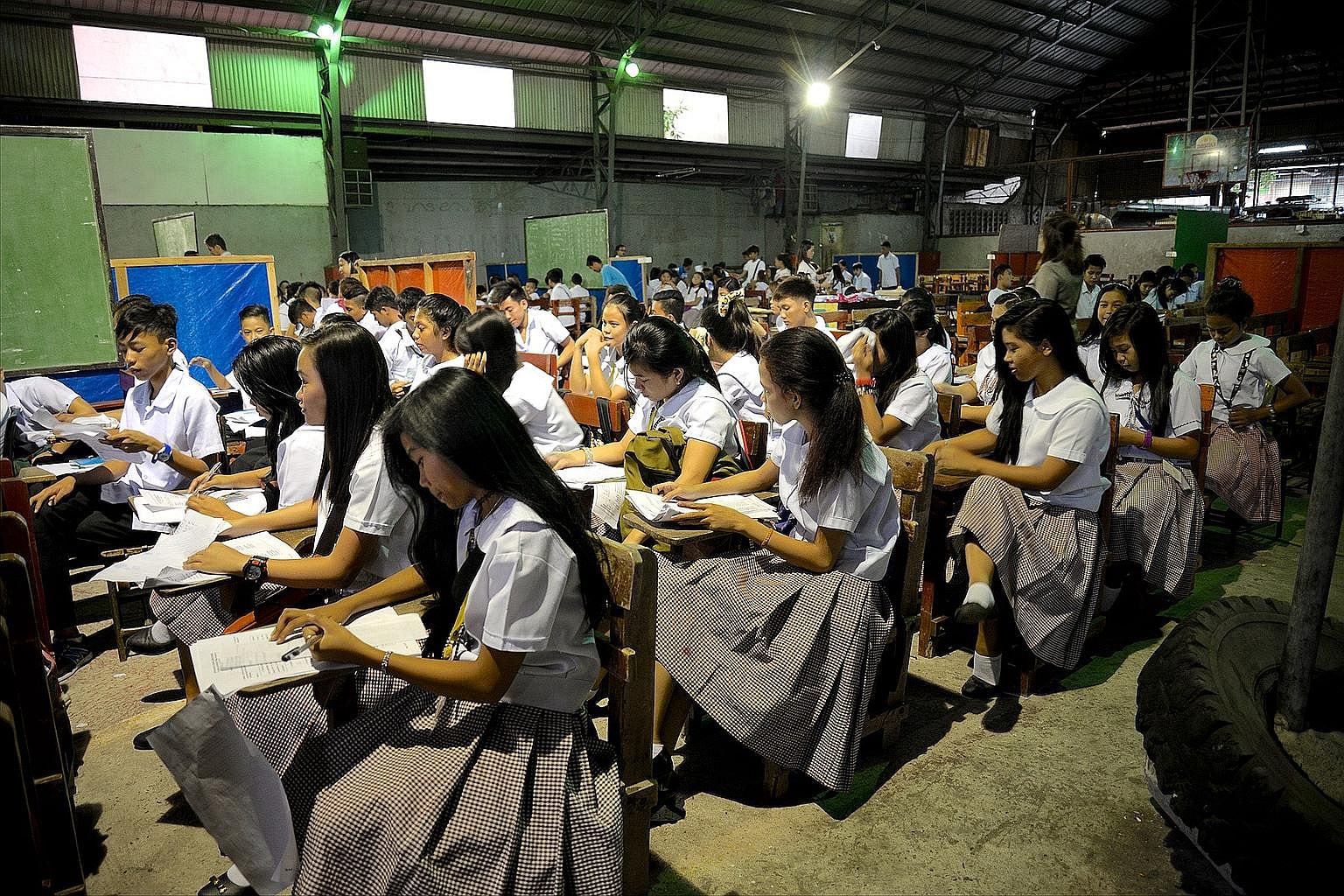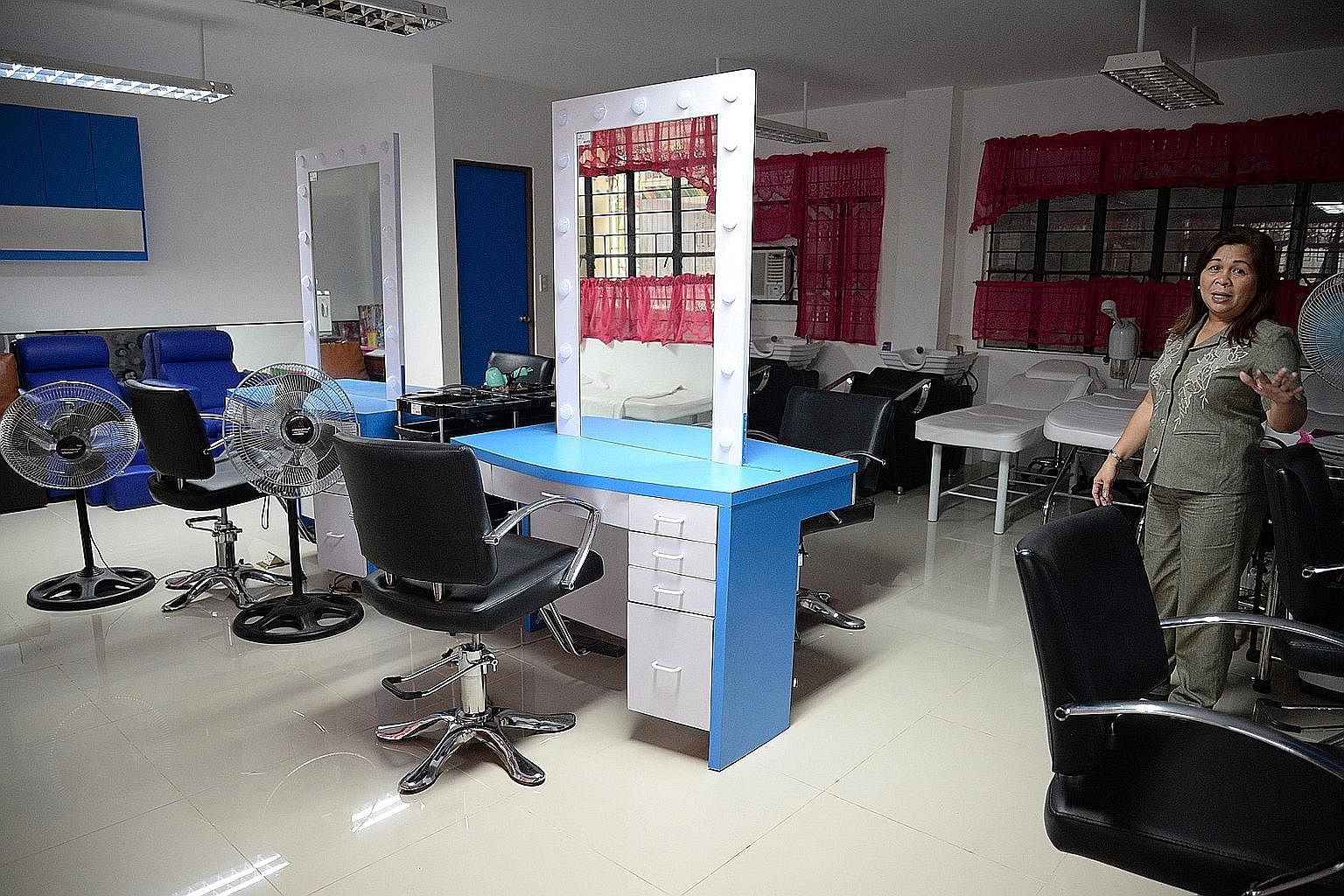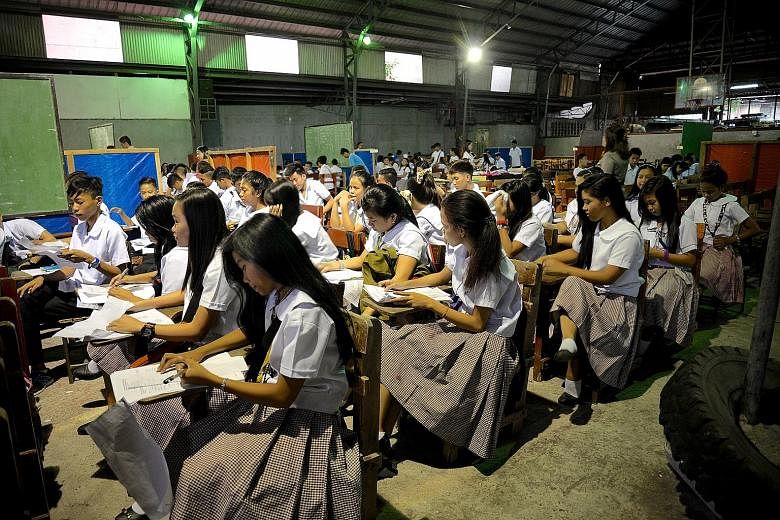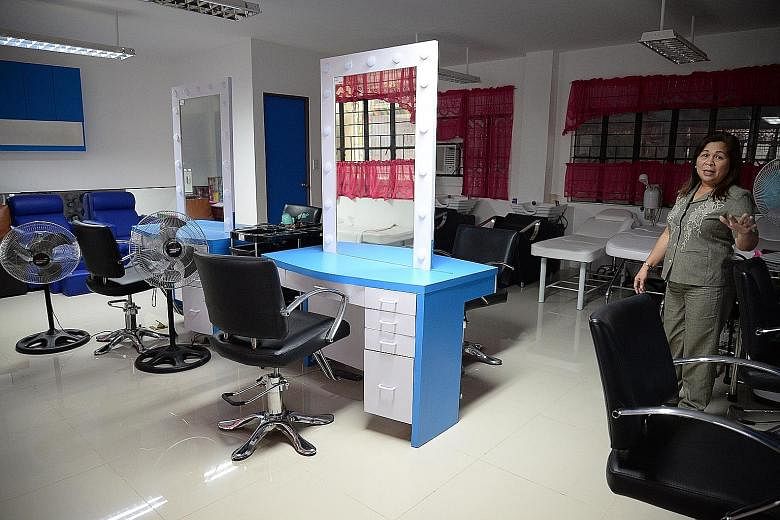MANILA • Back in 2009, teachers at a crowded public high school in Novaliches city, about an hour north of the capital Manila, were using bullhorns to teach classes with about 100 students each.
Some things have changed since then. The bullhorns are gone. Now, teachers use wireless lapel microphones. But each class still has at least 60 students.
Sometimes, classes are held in a space beneath a tree or a canopy or in a gymnasium. That makes the microphones even more necessary.
On paper, the Philippine public school system is humming along just fine. There are enough classrooms, textbooks, chairs and well-paid teachers to go around, and the national curriculum is being revised to meet the demands of a nation marching into the ranks of the First World, according to the authorities. The education department said in a 2015 Unesco report that it had achieved one-to-one student-textbook and student-seat ratios back in 2012.
But the situation on the ground tells a different story.

POOR FACILITIES
At a school tucked in one of Manila's coastal suburbs, hundreds of high school students attend classes inside a gymnasium, their classrooms separated by shoulder-high partitions of plywood, sacks and tarpaulins.
Some 1,600km away, in General Santos city in the restive southern island of Mindanao, over 350 pupils and students take lessons under a canopy. They attend classes in three shifts that start at 6am and last till 9pm. Others have had to settle for a space beneath a tree.
"How can you expect quality learning when you force children five to six years old to wake up so early in the morning so they can attend a 6am class? They are not ready to accept instructions that early because they are barely awake," said Ms France Castro, 49, secretary-general of the Alliance of Concerned Teachers.
At the San Rafael Technological School in Navotas city in northern Manila, students study in a gymnasium while a new school building is being constructed that will give the 1,008 students 16 classrooms, double what they had before.
But for now, distraction is a constant companion. "It is crowded and noisy, especially when everyone's talking at the same time, but you just have to focus," said Rosel Dagasdas, 14, who is in Grade 9.
TEACHER WOES
For teachers, meanwhile, it is a hard slog from one pay cheque to the next, given the low pay despite a teacher shortage.
They earn about 18,549 pesos (S$560) a month, about as much as an entry-level accountant or junior sales representative. But with the cost of living pegged at 32,000 pesos a month for a family of six, that is not much.

Mr Jericho Santiago, 24, who teaches students how to use computers at the General Emilio Aguinaldo National High School in Cavite province, two hours south of Manila, said that after government contributions and taxes, he has about 16,500 pesos left to spend.
Single and living with his mother, he gets by, but raising a family with his pay cheque is out of the question. "You'd be hard-pressed to give your family a decent life with a teacher's salary," he said.
Indeed, some teachers who are their families' sole breadwinners pile up debts to make ends meet. Some have had to pawn their ATM cards to loan sharks, who collect their salaries till their debts are paid. In the meantime, they get by through moonlighting - tutoring, a second teaching job, or hawking shoes and other wares.
With that and their heavy teaching duties, teachers are often too tired to give enough attention to their charges. Many teach six classes of at least 50 students a day, and also act as counsellors.
"Often, when I'm on my fifth class, I'm already so exhausted that all I want to do is sit down and rest. I feel sorry for the students because I can't give them 100 per cent anymore," said Ms Castro.
REFORM TOO SOON?
The move from a 10-year pre-university cycle to a K-12 programme - meant to align the Philippine education system with the rest of the world's - has ironically made things worse.
Before the programme was implemented in 2011, students went through six years of primary and four years of high school. They could then enrol at a technical school or go to college.
With the K-12 programme, kindergarten is now mandatory. Students then get six years of primary education, four years of junior high school (Grades 7 to 10), and two more years of senior high school (Grades 11 and 12). They can then opt to start working or go to a college or university.
The change meant that the public school system has had to absorb about a million kindergarteners.
With two extra years of senior high school also falling on their laps, public schools have had to build more classrooms, procure more textbooks and equipment, and hire more teachers. These have put a strain on already-meagre resources available to them.
Estimates are that, for the next school year, some 500,000 out of about 1.6 million students who are now in Grade 10 will have to transfer to private schools for senior high school because the public school system has no facilities for them. They will be the first batch of Grade 11 students under the new programme.
"We understand the need to transition to K-12, but the question is: Are we ready? In terms of budget, no. In terms of preparation for the basic needs of the pro-gramme like teachers, classrooms, equipment, no," said Ms Castro.
At San Rafael, school officials have had to print instruction materials for students in Grades 7 to 10 because no textbooks or reading material for several subjects were printed for the new curriculum under K-12.
As for the education authorities' idea of an online library that students could access anytime they wanted, the school's principal, Ms Joji Fernando, 55, said this assumed that students had computers at home. "Most of the students don't. Most of them are poor... So, we had to print the materials ourselves."
FALLING SHORT
The government has been trying to make things better. It has been setting aside more money to build a better public school system. It will spend 435.9 billion pesos this year on education, up from last year's 377.7 billion pesos.
Since President Benigno Aquino took over in 2010, the government has built over 67,000 classrooms and purchased some 2.9 million chairs, clearing a backlog left behind by his predecessor.
It has also hired more than 103,000 teachers, and endorsed Bills in Congress raising teachers' pay by at least 2,000 pesos.
But despite such efforts, the government is falling short.
Its education budget - nearing 500 billion pesos and making up the biggest chunk of the pie - accounts for just 2.5 per cent of gross domestic product, not even half of the 6 per cent recommended by the United Nations.
Last year, the education department said it spent about US$366 (S$525) per student. By comparison, Japan spent at least US$5,000, and Thailand about US$900. Singapore spent US$1,800 in 2009, according to the World Bank.
The fact is, with a population forecast to reach 104 million by the end of the year and 142 million by 2045, the Philippines is just playing catch-up. Enrolment in public schools grows at 2 per cent a year.
For the 2014-2015 school year, the public school system - roughly 47,000 schools - took in over 21 million students, 300,000 more than the previous year.
By one measure, the Philippine public school system has been a success. Out of some 80 million Filipinos 15 years and older, 96.3 per cent can read and write. By comparison, the global average is 86.3 per cent.
But when it comes to quality, much more needs to be done.
SKILLED LABOUR VS TOP-CLASS WORKFORCE
Economists reckon that the Philippines is in a "demographic sweet spot". Its population has a median age of 22.9 years, and more than half are of working age. Those above 65 years old make up just 4.5 per cent of the total, compared with 13 per cent in Singapore.
The young population is seen providing an abundant source of labour, not just at home but also abroad, that can, in turn, fuel consumption and growth, and propel the Philippines into the ranks of the developed world.
Yet, the bedrock of that assumption is the public school system and, right now, it is not yet primed to produce graduates who can power a First World state like Singapore or South Korea.
"What public schools are primed to produce is a skilled, but cheap, labour force for the global market," said Ms Castro.
"(Education officials) are saying that after Grade 12, students can already work as welders in Australia, baristas in Tokyo. We should be meeting goals for national industrialisation and modernisation, not producing graduates who we want to send abroad or work in call centres because that is all they are good for."
The answer to the riddle, education activists say, is simple: control population growth or the government just has to spend more on education.
Meanwhile, students try to make the best of their situation.
"It doesn't really matter if we're seated in front, in the middle, or at the back. If you really want to learn, then you will learn," Maria Mary Grace Paderogo, 14, said sagely.




